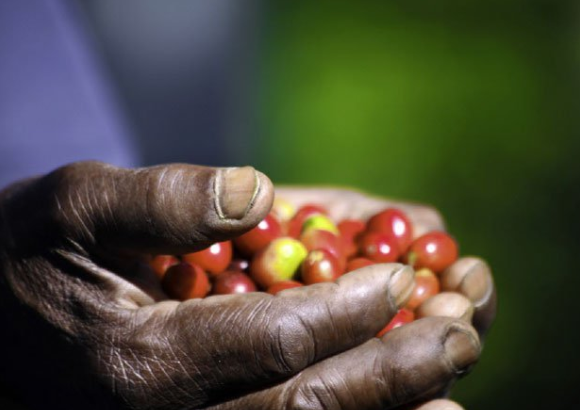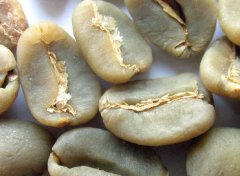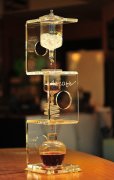Physical changes of raw beans during heat absorption of roasted coffee beans wholesale raw bean merchants
Physical changes of raw bean baking
Roasting changes the color of coffee beans, evaporates moisture, increases in volume, and makes coffee beans crisp. Almost all people in the coffee industry regard color as the standard to measure the roasting degree of coffee, even if they are named for different roasting degrees, but there is no consensus on the roasting degree symmetrical by each name in the coffee industry.
Color change
The first stage of roasting coffee beans is "drying", which is the only way for almost all raw coffee beans to be roasted. In the first few minutes of roasting coffee beans, the chlorophyll in raw beans degrades at high temperature, and the color gradually changes from green to yellow. Next, the coffee beans slowly changed from yellow to light brown, which was caused by Maillard's reaction. When the coffee beans are close to the first explosion, the coffee beans slowly turn dark brown due to the caramel reaction. If the coffee beans are deeply roasted, the coffee beans will turn black due to carbonization.
Traditional definition of baking degree
Light roasting gives coffee bright acidity, floral aroma, and fruit flavor. Compared with deep roasting, the aroma is weaker and the alcohol thickness is not high. Deep roasting gives the coffee a smoky, pungent, bitter and carbonized flavor. If it is extremely deep-roasted, the coffee tastes like charred and the alcohol thickness is lost.
The coffee industry in the world lacks different levels of naming for coffee roasting, so not only consumers but also coffee roasters sometimes get lost on this issue. The author will not provide the definition of different baking degree here, but the following naming of roasting degree can be described according to the color and image of coffee beans, which is easier for everyone to understand.
Cinnamon baking (Cinnamon)
Cinnamon is baked only because it looks like cinnamon in color, not tastes like cinnamon. Generally speaking, cinnamon baking didn't take long in the baking oven, and the beans were dropped as soon as the first explosion began. At present, only a small number of customers like this grassy, peanut-flavored cinnamon baking, which is not the mainstream. However, some large coffee companies sell cinnamon roasted coffee to cost-sensitive customers because cinnamon roasted beans lose less weight. A cup of cinnamon coffee roasted coffee, strong acidity, grass flavor, peanut flavor, with flower and grass aroma, mellow thickness.
Urban Bakery (City)
Urban baking occurs at the end of an explosion of coffee beans, or at the end of an explosion. This kind of baking alcohol is light in thickness and high in acidity. Urban baking is now very popular and is known as "the third wave of boutique coffee specified roasting degree". Historically, urban roasting has been the standard for Nordic coffee roasting. A cup of city roasted coffee has obvious acidity, red wine taste, fruit juice, obvious sweetness if roasted properly, floral and fruity aromas, slightly caramel sweetness and light mellow thickness. If it is not baked properly, there will be grass, lemon, and acerbic taste.
Full City Bakery (Full City)
The coffee beans came out of the oven just before the second explosion, and the beans were oiled. Most consumers like this baking degree because the acidity of the coffee is moderate and balanced, with a mellow caramel feeling and moderate alcohol thickness. A cup of Full City coffee caramel is full of flavor, like tasting ripe fruit, moderate thickness.
Vienna Bakery (Viennese)
The roasting degree in Vienna is when the coffee beans are baked in the early stage of the second explosion, that is, when the oil is just beginning to appear on the bean surface. Starbucks uses this baking degree. A cup of Viennese roasted coffee tastes sweet and bitter, full of caramel, spicy and sometimes nutty; mellow and thick, like syrup.
French baking (French)
French-baked beans have a lot of oil on the surface, with a spicy, bitter and coke taste. This baking degree has been unable to distinguish its uniqueness and manor characteristics. A cup of French-baked coffee tastes bitter, lampblack, caramel, medium or heavy.
Italian Bakery (Italian)
Most Italian baking is baked in medium baking. Isn't medium baking city baking? But of all the popular baking degrees today, it is the darkest, oilest, bitterest and most carbonized baking method. Almost all Italian baking smells unpleasant and pungent because the chlorogenic acid and cellulose in coffee beans are completely degraded and oxidized rapidly. A cup of Italian coffee coke is bitter, smoke, rotten, carbonized and moderately thick.
Organizational structure change
The microstructure of raw coffee beans is very orderly and dense, and the oil surrounds the cellulose group. When coffee is roasted, the resulting water vapor and carbon dioxide increase the pressure in the beans, causing the tissue structure to stretch and expand. A few minutes before the explosion, the coffee beans swelled big enough that the outer silver skin began to fall off and the silver skin wrapped inside was trapped. When the cellulose can no longer stretch, the fiber begins to crack, and gases such as water vapor instantly break through the fiber tissue, causing the first explosion.
Boutique coffee roasters usually seek medium and shallow roasting degrees, usually at the end of the first explosion and the beginning of the second explosion. After the completion of the explosion, the gas in the bean continues to produce, creating new pressure in the coffee bean cell. at the same time, due to the deepening of the roasting degree, the structure of the coffee bean becomes more fragile and is ready for a second explosion. Since the main cause of the first explosion is the pressure of water vapor to break through the fiber, the main cause of the second explosion is the sharp increase of carbon dioxide. Just after the second explosion, the oil began to attach to the bean wall, and if almost all bakers want to bake deep-baked beans, it mainly depends on the appearance of oil.
The internal development of coffee beans
In the stage of first explosion and second explosion in the baking process, the fiber structure of beans becomes fragile due to the increase of bean volume, water evaporation, generation and removal of other gases, and water vapor and carbon dioxide pierce beans riddled with holes. The deeper the baking degree is, the looser the beans are, the more fragile the internal environment of the beans is, and the internal development of the beans is complete. The well-developed coffee inside the beans is a harbinger of good grinding, high extraction rate and less miscellaneous flavor in the future.
In the process of baking, the internal development of beans lags behind the external development of beans. An experienced baker should know how to cook the inside of the beans while the color of the beans reaches the expected value. In ideal light baking, there should be almost no chromatic aberration in the bean and on the bean surface. The deeper the baking degree, the greater the color difference between the inside and outside of the bean. There will be a large chapter in this book to study this problem.
Bean body, density and weightlessness
According to the original water content of coffee beans, the degree of roasting, and the internal development of beans during baking, coffee beans generally lose about 12% to 24% of their original weight before and after baking. Assume that the water content of raw coffee beans before roasting is 10% 12%, the baking time is 11-12 minutes, and the weight loss rate of light roasted coffee beans is 11% 13%; the weight loss rate of coffee beans baked 30 seconds after the first explosion is 14% 16%; the weight loss rate at the beginning of the second explosion is 17% 18%; and the weight loss rate of deep oil roasting will be more than 22%. At present, the average weight loss rate of shallow baking in northern Europe, which is popular in the boutique coffee industry, is about 14% to 16%.
For shallow baking, 90% of the weight loss is the evaporation of water, and the other 10% includes some organic matter and carbon dioxide, as well as some dried silver skins, carbon monoxide, nitrogen, volatile compounds, and some volatile acids. The deeper the baking degree, the more organic content in the beans will disappear: 5%-8% of organic matter will be lost in medium baking and 12% in deep baking. When baking makes the beans lose weight, the volume of the beans will be 150% to 190% of the original, and the mass and density of the beans will be halved at the same time, and the volume will increase.
Vocabulary of this chapter
When First Crack explodes, when the beans absorb heat, the water turns into water vapor, breaking through the cell wall.
Second Crack second explosion, after the first explosion, beans absorb heat again, chemical reaction to form carbon dioxide, once again break through the sound of the cell wall.
Carbonisation carbonization reaction
Nordic Countries Nordic countries, namely Norway, Sweden, Finland and Denmark.
Pungent is spicy.
Ripe Fruit ripe fruit
Nutty nutty flavor
As sticky as Syrupy syrup
Rancid rotten
Carbon dioxide carbon dioxide
Carbon Monoxide carbon monoxide
Inside Inner Bean beans
Outside of Outer Bean beans
The English term "Spread" coffee describes the "color difference" inside and outside the bean after roasting.
Shrinkage shrinks, the English term for coffee, refers to the rate of weight loss of coffee beans caused by roasting.
Water Voper water vapor
Brittle is getting brittle.
Chaff Silver skin, we all know that there is another saying is "Silver Skin". The difference between the two is that "Silver Skin" refers to the silver skin in the state of raw beans before baking, while Chaff refers to the silver skin that is dried after baking.

Important Notice :
前街咖啡 FrontStreet Coffee has moved to new addredd:
FrontStreet Coffee Address: 315,Donghua East Road,GuangZhou
Tel:020 38364473
- Prev

Water content of coffee beans processed and stored fresh coffee beans fresh coffee
Boutique coffee has a rich and beautiful taste. Even if the coffee made of boutique coffee beans is not all fine coffee, it depends on whether it gives full play to the characteristics of coffee beans, whether it has a good taste, if not, it can not be called boutique coffee. The term boutique coffee was first coined by Ms. Knudsen of the United States in Coffee and Tea magazine, when
- Next

Low temperature extraction of coffee beans from fine tannic acid producing areas of iced coffee
Boutique coffee has a rich and beautiful taste. Even if the coffee made of boutique coffee beans is not all fine coffee, it depends on whether it gives full play to the characteristics of coffee beans, whether it has a good taste, if not, it can not be called boutique coffee. The term boutique coffee was first coined by Ms. Knudsen of the United States in Coffee and Tea magazine, when
Related
- Beginners will see the "Coffee pull flower" guide!
- What is the difference between ice blog purified milk and ordinary milk coffee?
- Why is the Philippines the largest producer of crops in Liberia?
- For coffee extraction, should the fine powder be retained?
- How does extracted espresso fill pressed powder? How much strength does it take to press the powder?
- How to make jasmine cold extract coffee? Is the jasmine + latte good?
- Will this little toy really make the coffee taste better? How does Lily Drip affect coffee extraction?
- Will the action of slapping the filter cup also affect coffee extraction?
- What's the difference between powder-to-water ratio and powder-to-liquid ratio?
- What is the Ethiopian local species? What does it have to do with Heirloom native species?

